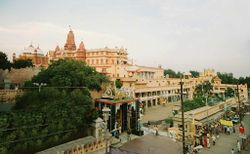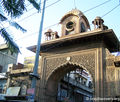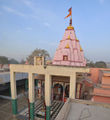Mathura
Introduction | Index | Marvels | Books | People | Establishments | Freedom Fighter | Image Gallery | Video
This website is under construction please visit our Hindi website "HI.BRAJDISCOVERY.ORG"

|
Other Related Links
|
Mathura / मथुरा

- Mathura is a holy city in the Indian state of Uttar Pradesh.
- It is located approximately 50 km north of Agra, and 150 km south of Delhi; about twenty kilometers from holy Vrindavan.
- Mathura is believed to be the third oldest living city of the world, only behind Kashi (Varanasi) and Rome.
- It is the administrative centre of Mathura District of Uttar Pradesh.
- During the ancient period, this was an economic hub, located at the junction of some relatively important caravan routes.
- Mathura is reputed to be the birthplace of Krishna at the centre of Braj, called Krishn Janm Bhumi, literary 'Krishna's birth place'.
- Muttra is the location of the plantation where Jonathan Small worked in the Sherlock Holmes story "The Sign of Four". Though Muttra sounds like Mathura it is a fictitious place. Mathura never had indigo plantations around it and Mathura is nowhere near the Northwest Provinces.
Introduction of Mathura
|
Introduction |
Mathura is believed to be the third oldest living city of the world, only behind Kashi (Varanasi) and Rome. For the past more than 2,500 years it has witnessed many dynasties and innumerable rulers deciding its destiny and ruling its fate. Nature, mainly through flooding from River Yamuna has wrecked less havoc on its temples, shrines, stupas and monasteries than the waves of marauding invaders. Being a prominent religious city and located on the main highway it has always been on the hit list of the invading armies. Its dauntless spirit always made it to rise up after every fall. Krishna told Arjun in Gita that whenever there is darkness and loss of Dharma he would take incarnation to uplift and reestablish the Dharma (order and rule of law), ominously Mathura recovered miraculously after its devastation at the hands of Huns. After Sikander Lodhi's destruction it saw the revival through Chaitanya Mahaprabhu's disciples, Vallabhacharya, music maestro Haridas, Mirabai, Surdas, and innumerable devotee poets and saints. Again when Aurangzeb let loose hell over this sacred city, Jats and Marathas proved saviours of its cultural vestiges. People mostly regarded it only as a Vaishnava religious city and termed Krishna, its presiding deity, as a mythological figure. It was rediscovered by the civilized world in 1836 when Colonel L.R. Stacy chanced upon a mound and got unearthed an antiquarian masterpiece popularly known as Silenus and a Cage-bearing Yakshi. It turned out to be a groundbreaking momentous discovery. The renowned archaeologist Alexander Cunningham became quite fascinated with Mathura. Between 1853 and 1882 he made several trips to the city and its outskirts and carried out excavation work in different mounds. These mounds proved to be a goldmine of classic sculptures. He and an archaeologist administrator, F.S. Growse (Collector of Mathura) made herculean efforts in bringing out innumerable sculptures and art pieces and in the process unveiled the historical, social, economic and political life of Mathura in last about 2,000 years. Recovery of huge haul of sculptures, inscribed stone-pieces, coins and architraves proved beyond doubt that Mathura in ancient times was a great centre where not only Hinduism, but Buddhism and Jainism also flourished. This book is a humble attempt to piece together these scattered historical facts. It is rather a spiritual journey into Mathura's colourful history. There is some magnetism in Mathura, popularly known as Brajbhoomi, because once in Mathura's lands, one feels immersed in the devotional feelings. This magical land erstwhile was a melting pot of a diverse cultural heritage—rich, diverse and colourful. Hence we hope that tourists, pilgrims and the followers of Krishna, Buddha and Mahavira will find in this book some food for their thoughts. Mathura is such an ancient and sacred city that it should have a huge number of visitors to it. But in comparison to Varanasi or Rome (other cities older than it), the number of its pilgrims, tourists and visitors are far less. Reason being its historical, religious and cultural importance has not yet been publicized properly and aggressively. Hence, feeling a spiritual urge to fulfill this vacuum and promote the glory of ancient Mathura this treatise is being brought out.
Mathura of Today
As per mythological belief Mathura is eternally enjoying the protection of Krishna's fabled wheel (Sudarshana Chakra). For a visitor, the walled city of Mathura is the place for chaste Brajbhasha, peda, dahi (curd), milk, and of course its divine posterboy— Krishna. `Radhey, Radhey! chanting pandas keep alive the township's age-old culture and are always ready to recount innumerable anecdotes related to the lilas of their dear Lord Krishna. Howsoever incongruous it may seem, the congested walled city with its century-old buildings, ahatas, bagichis, akharas and galis–has gelled well with modern antiseptic Mathura. Though the ancient tin lok se nyari Mathura is gone, yet the modern small town continues brimming with enthusiasm and life. A century or more back, the ancient mounds gave way to the mansions, havelis and kothis and now these crumbling mansions are being marred or demolished to make way for residential colonies, commercial establishments and multi-storeyed apartments. The historically oldest structures of the city chronologically are–Satiburj (17th century), Manoharpura's mosque (Ahmad Shah's period), Jama Masjid of Chowk (Aurangzeb's times), Idgah Masjid (Aurangzeb's period), Dwarkadhish Mandir (19th century), old Museum (19th century), Lala Babu's cenotaph (19th century), Collectorate (1860), and Sacred Heart Catholic Church (19th century). It is difficult to come across an original walled city house today. Old era is gone and so has its architecture and lifestyle. Today's generation does not realize what a treat it is to live in huge, spacious, airy mansions, hence only a few dozen houses have got old dalans, sahans and small gardens in their courtyards. Multicultural flair still exists in the city hence adherents of every creed and religion have got their place of worship here. While the Jama Masjid of Chowk dominates the landscape of the old walled city, the spires of Krishna Janmabhumi temple have got an aura of highest religiosity. JambuSwami Jain temple of Chaurasi and Sacred Heart Church of Sadar Bazar have got their own believers. The entire walled city of Mathura always bustles with activity as there is one festivity or other through out the year.
Chaubes of Mathura
(न केशव समो देव न मथुरा समो द्विज)
(Na Keshava samo deva na Mathura samo dvija)
[i.e No god like Keshava, and no Brahman like a Mathuriya Chaube.] Thus is said in the Varaha Purana about Krishna and the Chaubes of Mathura. Since then little has changed in Chaubes. They are a peculiar race and must not be passed over so summarily. Till middle of 20th century they were very celebrated as wrestlers. Their Bhuteshwar Akhara (arena) was popular far and wide in whole of North India. In the religious Sanskrit text `Mathura Mahatmya', their learning and other virtues also are profusely extolled. Extremely fair in colour, sporting tilak on their forehead, wearing rudraksha beaded garlands in their necks, frequently chanting `Radhey, Radhey' while greeting each other, sporting crisp muslin kurti and dhoti they may always be seen with their portly forms lolling about near the most popular ghats and temples. One of their most noticeable peculiarities is that they are very reluctant to make a match with an outsider, and if by any possibility it can be managed, will always find bridegrooms for their daughters among the residents of the town. Hence the popular saying:
‘मथुरा की बेटी गोकुल की गाय
कर्म फूटे तो अन्त कू जाय’
Which may thus be roughly rendered: `Mathura's daughters and Gokul's cows will never move out while fate allows.' Because as is implied, there is no other place where they are likely to be so well off. In the later half of 19th century a considerable migration of Chaube populace was made to Mainpuri, where the Mathuria Chaubes now form a large and wealthy section of the community and are in every way of life better than the parent stock. On important festive occasions bhang-rolling groups of Chaubes are a sight worth enjoying. They complete the masti (revelry) of Braj.
Jainism In Krishna's Land
Neminath was the 22nd Tirthankara of Jain religion. He was the cousin brother of Lord Krishna. There is a place called Shauripur (near Bateswar) in Bah Tehsil of district Agra. King of Shauripur Andhak Vrishni had ten sons. Eldest son was Samudravijai, while the youngest one was Vasudeo. Neminath took birth in the house of Samudravijai, while Sri Krishna was born in the house of Vasudeo. Out of fear from Jarasandh Yadavas left Shauripur lock, stock and barrel and got settled at Dwarkapuri. There Neminath became an ascetic. He left behind his would-be-bride and after scaling the Girnar hilltop started his penance there. Following the footsteps of Lord Rishabhdeo, he renounced his cloths and turned a digambara (bare bodied). Vasudeo married the sister of Mathura's king Kansa and moved to stay there. Hence being related to each other Sri Krishna and his devotees and followers of Jain Tirthankara Neminath had no acrimony between them. Gradually Mathura turned into a centre of Jainism as well. The inscriptions on artpieces discovered from the Kankali mound of Mathura date from second century BC to fifth century AD; hence they sufficiently prove the antiquity of Mathura as a very old and important centre of Jainism.
Historian and renowned archaeologist Fuhrer narrates the antiquity of Jainism at Mathura like this: "This stupa is so ancient that till writing of the inscription the original description of the stupa has gone out of local populace's memory." Innumerable Jain sculptures discovered from several sites at Mathura prove beyond doubt that Jainism remained prevalent in this region for many centuries and also got patronage of many of the contemporary successive rulers of this part of the world.
Jambu Swami (Chaurasi) Jain mandir is located on the outskirts of Mathura city, close to the Govardhan crossing on Agra–Delhi bypass road. It is believed that Jambu Swami here practiced penance, and that his name is recorded in an old inscription on a stone slab that is still preserved under the altar. He is reputed the last of the Kevalis, or divinely inspired teachers, being the pupil of Sudharma, who was the only surviving disciple of Mahavira, the great apostle of the Digambaras. In this magnificent Jain temple are placed his footprints. Every year between Kartika Krishna's dvitiya to astami, Rathotsava (chariot-pulling), an annual fair, is held here. Kankali mound was near to it from where hundreds of Jaina sculptures were found out. One statue of the 24th Tirthankara Lord Mahavira was discovered from Chaurasi mound, which is said to have been chiseled during Kumargupta's reign. On the Chaurasi mound stands the Jambu Swami temple.
A famous art historian writing in `Indian Sculpture Art', reiterates that Mathura's Shunga Age art is mainly of Jain order.
Mathura, up to the end of 3rd century AD flourished as an important centre of Jaina art and iconography. In comparison to contemporary Jaina centres in the other parts of the country, the position of Mathura is much superior. Epigraphical sources reveal that during 2nd century BC to about 3rd century AD several Jaina monuments existed at Mathura; famous being Sanctuary, hall, cistern and a Jaina temple built by the courtesan Vasu.
Stupa at Kankali Tila termed as deva-nirmita (built by God) due to its hoary antiquity, which continued to exist at least up to sam. 1036, that is, 979 AD.
Following archaeological material, strictly Jaina in nature, has come down to us from the Mathura region:
Some symbols, including 20 Ayagapattas and 5 Silapattas. Figures of seated Tirthankaras, 93 in number. Figures of standing Tirthankaras, 26 in number.
Male Divinities, 17 representations. Female Divinities, 8 representations.
The Jainas had their own stupas, and stupa worship has been depicted in a number of sculptures. Actual Jaina stupas were very few but the most important of them was that of Mathura at Kankali Tila. From Mathura 27 stone tablets, mostly square, or sometimes rectangular in shape, have been brought to light. Very often in the inscriptions appearing on them they have been named as Ayagapatta or Silapattas installed for the worship of the Arhats. The word Ayagapatta is obviously a compound word meaning a tablet or patta installed in an ayaga (place of worship).
Ayagapattas were installed on high platforms in the stupa premises, they served as media for the worship of the stupa, and flowers and other offerings were directly placed on them. Most of the Ayagapattas have been roughly attributed to a period between the times of Mahakshatrapa Shodas and Kushanas. The Ayagapattas and Silapattas show a very rich variety of religious and secular symbols such as the group of eight or even fourteen auspicious marks (nangalas), the wish fulfilling tree (Kalpavriksha), full vase (purnaghata), stupa, dragons etc. Ayagapattas and Silapattas are carved on one side only. In the border frame of the slab there appear motifs like wine creepers (drakshalata), sacred symbols (mangalas), winged animals (ihamrigas) and dancing figures. In the inner field along with the decorative motifs and auspicious marks, there are to be seen some sacred objects such as the wheel (chakra) or sacred seat (bhadrasana). In the centre sits the Jina. National Museum Delhi, State Museum Lucknow and Government Museum Mathura have got the following Ayagapattas as their pride possession.
Gallery
Krishna Birth Place, Mathura
Govind Deo Temple, Vrindavan, Mathura
Rang Nath Temple, Vrindavan, Mathura
Banke Bihari Temple, Vrindavan, Mathura
Kusum Sarovar, Govardhan, Mathura
Haridev Temple, Govardhan, Mathura
Radha Rani Temple, Barsana, Mathura
Baldev Temple, Baldev, Mathura
Vishram Ghat, Mathura
Chaurasi Jain Temple, Mathura
Sati Burj, Mathura
Holi Gate, Mathura
Potra Kund, Mathura
Dwarkadhish Temple, Mathura
Bhuteshwar Mahadev Temple, Mathura
Birla Temple, Mathura
Radha Krishna, Krishna Birth Place, Mathura
Vishram Ghat, Mathura
Rangeshwar Mahadev, Mathura























